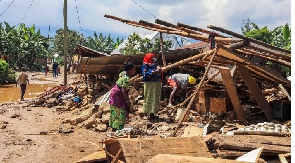Countries in the wider Eastern Africa may have to ready themselves for a season of heavy rain, with potential flooding and destruction of property.
A new forecast says the region should expect above-average rainfall from October to December, linked to the El Nino weather phenomenon.
According to data gathered by IGAD's Climate Prediction and Applications Centre (ICPAC), there is more than 80 percent likelihood of wetter than usual October-December rains across the Horn of Africa, especially southern Ethiopia, Eastern Kenya and Southern Somalia. ICPAC warned countries in the region to expect torrential rains and possible flooding.
“We have now entered El Nino conditions which for eastern Africa are synonymous with wetter conditions during the October-November-December season,” said Guleid Artan, the director of ICPAC.
The rains may be welcome for rain-dependent farmers, especially since the region has endured five successive droughts. But heavy rains tend to cause destruction, according to assessments of a recent deluge in parts of the region.
Flooding could also rebuild disease infestation, especially malaria, as well as waterborne diseases like cholera. As of July 17, a total of 1,861 cholera cases and 194 related deaths had been reported in Kenya.
Locusts crisis
Some isolated areas such as southwest Uganda and Southwestern South Sudan are expected to experience drier than usual conditions.
The El Nino phenomenon portends a looming crisis for the region that recently suffered one of the worst droughts in four decades, compounded by conflicts, impact of Covid-19 pandemic and rising food prices due to Ukraine-Russia war which have collectively exposed an estimated 60 million people to hunger.
In Somalia, drought resulted in death of 43, 000 people in 2022 according to the World Health Organisation, with May flash floods displacing 250, 000 people.
The heavy rains will increase chances of desert locust invasion as wetter conditions will offer favourable breeding ground for the destructive insects already proliferating at alarming levels in parts of the region. This will result in massive destruction of food and pasture, causing risk to livelihoods and food security.
The UN’s Food and Agriculture Organisation (FAO) in a recent forecast indicated that immature locusts were sighted in a lowland area in western Afar north of Chifra in neighbouring Ethiopia on July 26 this year and another smaller group in Chifra days later.
“A few immature swarms were spotted at Tigray highlands, east of Adigrat the first week of August,” the agency said in August 16 forecast with rains that have been falling in Tigray since July offering breeding grounds.
A few groups of mature adult desert locusts had earlier been sighted in the Red Sea hills in neighbouring Sudan with likelihood of them moving to Kenya if there are cooler conditions or high winds remaining high.
More than $200 million was spent in tackling the 2019-2021 locust invasion in the region with the funds mainly used to procure insecticides, vehicles, spray equipment and facilitate human resource in surveillance of the swarms and control activities (spraying).
Now FAO in partnership with the British Embassy in Mogadishu has already launched a $3.8 million preparedness programme in areas expected to face greater risks in Somalia ahead of the anticipated climate phenomenon which could put the lives of 1.2 million people within the riverine areas at risk.
Africa News of Monday, 28 August 2023
Source: theeastafrican.co.ke

















